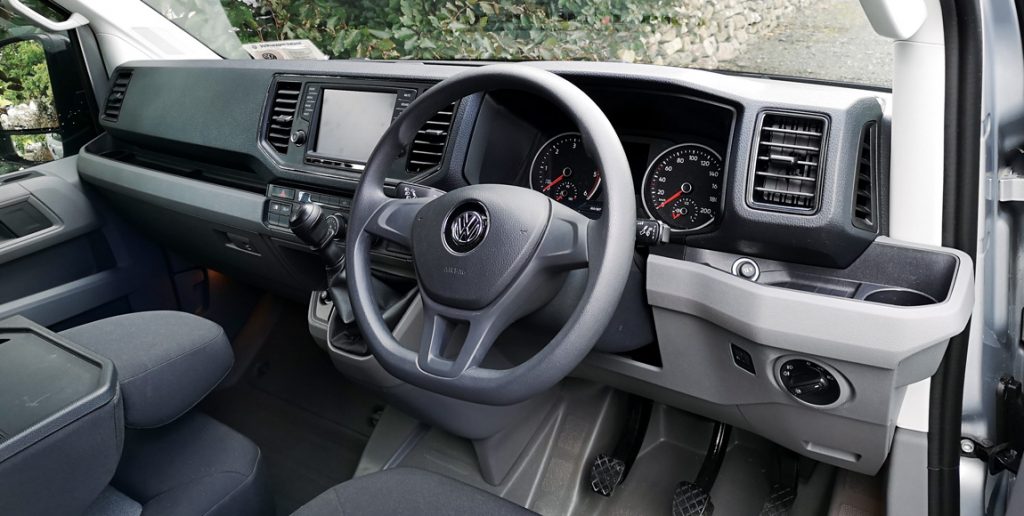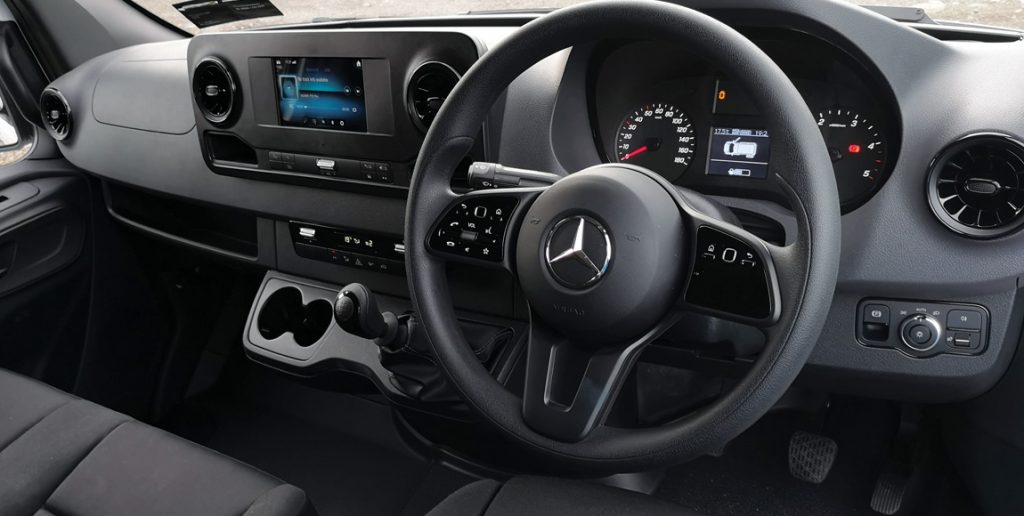Best of Frenemies go head to head

It’s the large-van battle we’ve all been waiting for! CATHAL DOYLE of Fleet Magazine, pits the all-new, all-Mercedes-Benz Sprinter against the all-new, all-Volkswagen Crafter.
Divorce is rarely pretty. When separation occurs between two erstwhile partners, neither wants to feel that they are the losing party. Both want to be able to move on and say they are better off going it alone than in partnership.
That’s what makes this van comparison so fascinating. In their previous guises the Mercedes-Benz Sprinter and Volkswagen Crafter were the closest of siblings; made in the same German factory, with only badging and a few minor details marking them apart.
The two brands have now gone their separate ways with all-new, completely different models. Both come in numerous length, height and payload options, differing body types as well as the choice of front, rear or all-wheel drive.
It needs to be pointed out that the two vans compared here aren’t direct rivals insofar as the Crafter tested was front-wheel driven (a new layout offered on both vehicles) while the Sprinter put its power down via the rear wheels.
Nevertheless, they shared a lot in common; both being long-wheelbase, high-roof models offering similar load capacity and payloads, and boasting identical power outputs – enough for a valid comparison to be made.
Styling and Appearance
It’s fair to say that both models are winners here. How a van looks is hardly top of the agenda for most prospective owners, but it is important that it fits in with other vehicles in the manufacturer’s line-up.
Both are fresh-looking designs, with the Sprinter carrying distinct cues from the outgoing model. This is a good thing – when it comes to brand association, the Mercedes-Benz three-pointed-star badge is second to none, and plenty of customers will choose it on the basis of being reassuringly familiar.
The Crafter is, arguably, the sharper looking of the two, with crisp, strong lines and, crucially, a strong family styling link with the smaller Caddy and Transporter. This will make it instantly appealing to existing Volkswagen customers who need to add a bigger vehicle to their fleet.

Interior
The days of van interiors being poor relations to their passenger-car siblings have well and truly passed. From ergonomics to storage, designers recognise that van drivers spend long hours in their vehicles and have tailored them to meet these needs.
If the switchgear and controls in the old Crafter betrayed its Mercedes-Benz lineage, the new Crafter is 100-percent Volkswagen Commercial Vehicles in looks and layout. One could step up from a Transporter and feel immediately at home.
Where it scores over the Sprinter is in the practicality of the storage areas, where little details like three door pockets compared to two in the Mercedes-Benz, and the handy storage compartment on top of the dash, can make a difference. Ergonomically it’s spot on, too, with all the controls falling well to hand just where they are needed.
Against that, the Sprinter has more of a wow factor when sitting in it, notably the MBUX multimedia system and multi-function steering wheel that give it a distinctive car-like feel. Other differences are more down to personal preferences. For instance, the Sprinter has an electronic handbrake versus the physical unit on the Crafter.
Build quality appears very robust on both models, and neither exhibited any hint of rattles or creaks during their time with us. Seats in both are comfortable, with the driver’s seat in the Sprinter probably edging it for support, though the Crafter tested here scored on practicality as the middle seat could be lowered to form a useful desk – the Sprinter’s two passenger seats were fixed.

Equipment
The Sprinter tested was a pre-production model and, as such, boasted a number of additional features not offered as standard. That said, it still beat the Crafter on features, as both the MBUX multimedia system and multi-function steering wheel are offered as standard.
Cruise control is standard on rear-wheel drive (RWD) models of the Sprinter, though optional on front-wheel drive (FWD) versions, whereas cruise control is available only in Trendline trim on the Crafter.
Also standard on the Sprinter is a very useful reversing camera – at just under seven metres in length, both of these vans need care when manoeuvring. The absence of either a camera or sensors on the Crafter – both optional extras – meant it was the Sprinter that was much easier
to position in tight situations. In terms of safety, both vehicles come with cross-wind assistance systems on all versions.
Driving
Despite their size, both these vans are easy to jump into and drive away. That they feel quite different to drive is probably down to the fact we are comparing front-wheel drive (FWD) against rear-wheel drive (RWD). As such, we preferred the Crafter’s FWD dynamics, which felt less clunky than that on the Sprinter, while the steering felt more direct. Typically, though, RWD vans tend to be a bit less refined, so we cannot mark the Sprinter down on that basis.
Both vans tested here developed 104 kW (140 hp), which felt more than adequate unless operating at maximum payloads.
Noise wise, they returned virtually identical results, with the Crafter recording a maximum of 86 dB in the cabin compared to 87 for the Sprinter, while both averaged out at 72 dB.
Fuel consumption will obviously differ hugely depending on speeds and what’s being carried, but we were pleasantly surprised to note that both vans could return around
7,0 l/100 km when driven gently, with the Sprinter just shading it overall.
Load Practicality
Comparing two models like these directly is largely a fruitless exercise. With literally hundreds of variants available, there will nearly always be another version to meet a particular need. That said, the two vans tested here match each other remarkably closely, with just millimetres separating most dimensions. It is worth noting that the Crafter can fit an extra 30 mm between the wheel arches, while the side door also has a wider aperture.
Value for money
It’s unfair to directly compare the two vans tested as the Sprinter is a pre-production model with extras fitted. Mercedes-Benz doesn’t offer an L3 H2 model in FWD, but the comparative Crafter in RWD has an on the road price that is very close to the Sprinter’s ex-factory price.
The Sprinter does boast better equipment levels as standard, but for a minimal outlay you can upgrade to Trendline trim in the Crafter, which matches many of the extras on the Sprinter.
Both should hold their value well over a number of years.
Verdict
It almost goes without saying that both the Mercedes-Benz Sprinter and the Volkswagen Crafter are excellent examples of their genre, offering pretty much everything a van driver could need today. The choice would be largely down to personal preference.
If a practical office on the move is required, the Crafter offers better storage and work space. As tested, we also preferred it to drive, albeit with the caveat of comparing FWD versus RWD. Against that, the Sprinter’s cabin is more plush, and the reversing camera fitted as standard is not to be sniffed at.
There’s little to choose between these two models on most levels, but if we had to make a choice, the Crafter upgraded to Trendline trim would just about shade it overall.
*The all-new Mercedes-Benz Sprinter makes its South African debut in the first quarter of the year – ed.
Published by
Focus on Transport
focusmagsa




